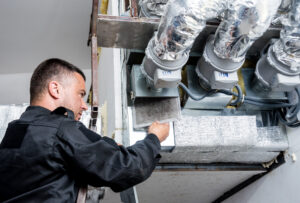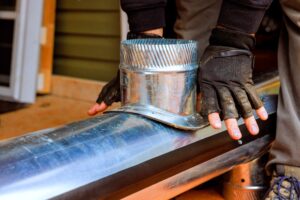When your cooling system kicks on during peak summer temperatures, it relies on your ductwork to efficiently deliver conditioned air throughout your home. Spring is an ideal time to address leaky or poorly sealed ducts, which can waste energy, restrict airflow, and circulate pollutants. Monarch Home Services specializes in professional duct sealing solutions to optimize airflow and HVAC performance before peak cooling season.

Identifying the Need for Duct Sealing
Even if your HVAC system appears to be functioning correctly, minor duct leaks may impact performance and cause long-term problems. Look for these signs that your ducts need sealing.
High Energy Bills
A sudden spike in utility bills may indicate underlying ductwork problems. If your energy costs increase but your typical AC usage hasn’t changed, gaps in your ductwork may allow conditioned air to escape and strain your HVAC system. Your HVAC system compensates by using more energy to maintain indoor temperatures, spiking energy bills.
Uneven Temperatures
Rooms or spaces that feel warmer or cooler than others often signal airflow issues. Leaks or gaps can allow air to escape or disrupt pressure in specific duct lines, making it difficult for your HVAC system to cool your home evenly.
Poor Indoor Air Quality and High Humidity
Leaky ducts may draw in dust, allergens, and moisture from drafty attics or unsealed basements and circulate them throughout your home, worsening indoor air quality. You may experience worsening respiratory issues, such as allergic reactions or asthma flare-ups, or notice dust accumulating more quickly on surfaces and around vents.
Stuffy Rooms
Restricted airflow leaves rooms feeling stagnant. Without a sealed path, air can’t circulate adequately through these spaces, accumulating airborne particles and creating a stale environment, even when the HVAC system is active.
Musty or Unpleasant Odors
Odors may come from the air your ducts pull in. Leaks in humid basements, musty attics, or contaminated crawl spaces can draw in and recirculate unpleasant smells.
Visible Ductwork Damage or Gaps
Poor design, gradual wear, and other factors may cause your ductwork to become cracked or separated. In spaces with exposed ductwork, you may uncover damage — look for disconnected joints, sagging, or sections held together by failing tape.

Impact of Leaky Ducts on Indoor Air Quality
Clean indoor air is important for your household’s health and comfort. Even minor leaks in your ductwork impact your indoor air quality and may cause:
- Congestion and sneezing
- Coughing and throat irritation
- Shortness of breath
- Asthma attacks
- Itchy and watery eyes
- Skin reactions
- Fatigue and headaches
Increased Airborne Contaminants
Leaky ductwork compromises indoor air quality by allowing unfiltered air inside, becoming a distribution path for pollutants rather than a barrier.
In a well-sealed system, return ducts pull indoor air back to the HVAC unit for filtration, conditioning, and redistribution. However, when gaps, cracks, or disconnected sections are present, the system may draw air from areas containing dust, pollen, volatile organic compounds (VOCs), pest droppings, and other contaminants. As a result, pollutants bypass filtration and enter the home’s supply air.
Condensation and Mold Growth
When duct leaks allow warmth and moisture to enter cooler duct pathways, condensation forms inside the ducts. High humidity and organic materials, such as dust, create a favorable environment for mold and mildew to grow. Ductwork mold isn’t always visible, but spores can become airborne and circulate throughout your home.
Energy Efficiency Benefits of Proper Duct Sealing
Heating and cooling account for a significant portion of residential energy use. In many homes, duct leaks are responsible for approximately 20% to 30% of thermal energy loss, resulting in higher utility bills and reduced HVAC performance.
Proper duct sealing directs air toward spaces in your home efficiently and minimizes thermal loss. Your HVAC system uses less energy to maintain indoor temperatures, lowering utility bills without compromising cooling performance.
Maintaining Your Ductwork for Optimal HVAC Performance
Duct sealing works best when paired with proper HVAC maintenance. Professional tune-ups provide advanced care for your system, and this proactive approach protects your ductwork from damage or airflow problems while optimizing the rest of your HVAC equipment’s performance.
Between professional HVAC services, use these strategies to enhance ductwork airflow and prevent inefficiencies:
- Inspect and replace air filters regularly.
- Install a smart thermostat.
- Keep vents open and unobstructed by furniture or belongings.
- Upgrade your home’s insulation.
- Seal gaps around doors and windows.
Scheduling Your Duct Sealing Service
Sealing your ducts in the spring is an opportunity to reinforce your HVAC system and enable optimal performance ahead of high summer demand.
A professional duct sealing service begins with a meticulous inspection, during which technicians look for disconnected duct segments and gaps, visible damage, airflow restrictions, and other signs. Once they identify the exact problem, they tailor their service to your ductwork’s needs using industry-standard duct sealing solutions, such as mastic sealant, AeroSeal technology, or duct insulation. After sealing, your technician tests and verifies proper airflow and pressure in your system.

Prepare for the Cooling Season With Spring Duct Sealing
Monarch Home Services brings trusted expertise to every home we serve. With a reputation built on precision, honesty, and lasting results, we use a thorough approach to duct sealing that focuses on long-term efficiency and improving indoor air quality.
Contact us at Monarch Home Services today to schedule your duct sealing appointment and ensure a comfortable and energy-efficient home environment. Don’t wait for issues to arise — proactively maintain your ductwork this spring for a cool and comfortable summer.


